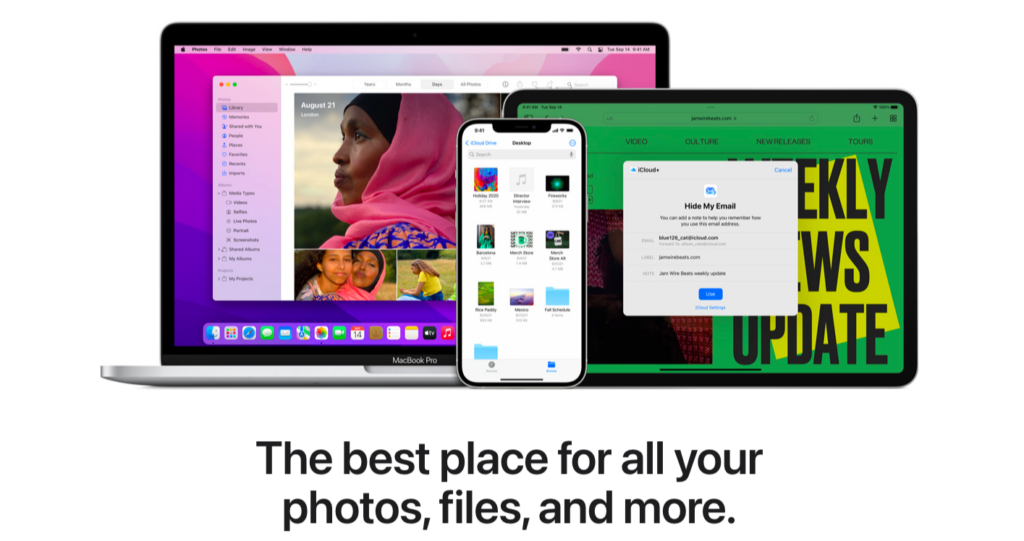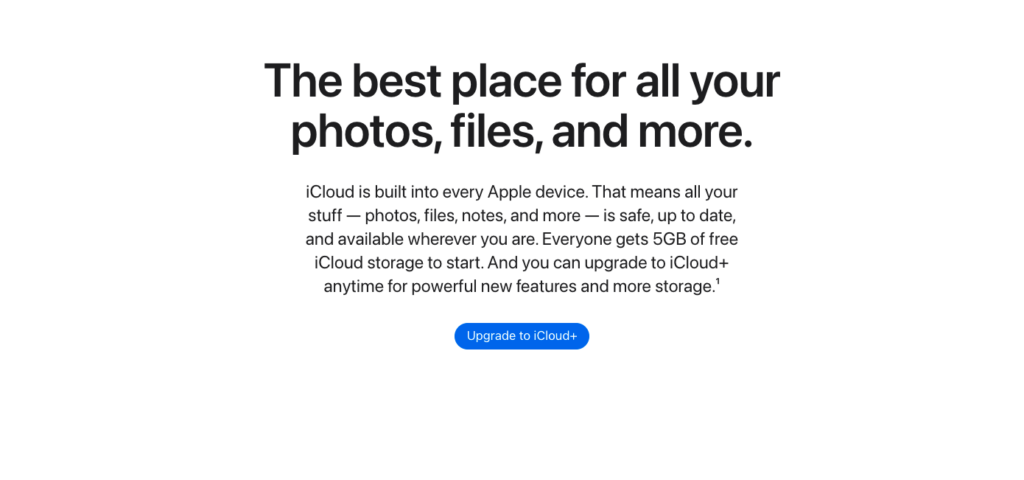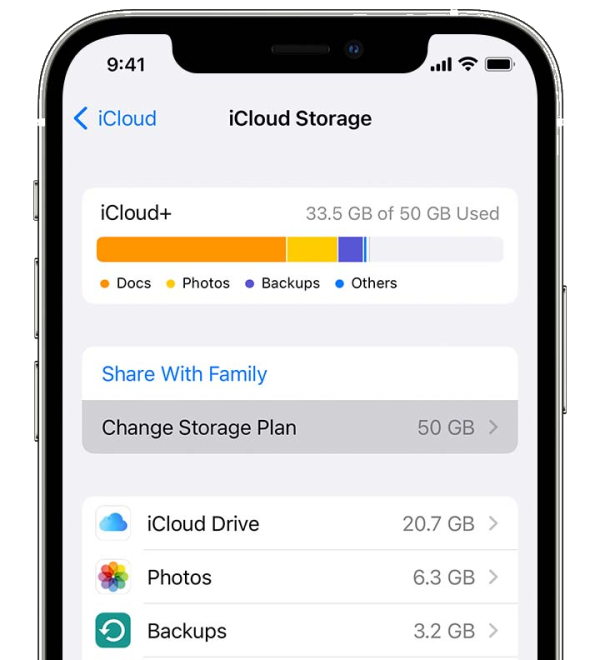Have you noticed that your iCloud storage seems to be filling up suspiciously quickly? Or worse, maybe you’ve already got an “iCloud Storage Is Full” notification on your phone and aren’t sure what to do?
Managing your iCloud storage can be tricky, especially since Apple only gives its customers 5GB of free storage space. And if you don’t want to pay for more, you’re going to have to get smart about how you manage your storage space.
In this article, I’ll break down some reactive and proactive strategies for managing your iCloud storage space and making sure you’re using it in the smartest and most efficient way.
Summary: How to Manage Storage on iCloud
- Proactive management strategies: turn off Backups, disable unnecessary apps from backing up to iCloud, turn off Photo Library and use My Photo Stream to store your pictures and videos instead, and find an alternative cloud storage solution.
- Reactive management strategies: find out which files are taking up the most space in your iCloud storage and delete them.
What is iCloud Storage?

If you’re using an iPhone, iPad, or iPod touch, it’s crucial to back up your device to avoid losing important data.
Apple provides two backup options: device backups and iCloud backups.
Device backups allow you to store a backup of your device on your computer’s hard drive.
Meanwhile, iCloud backups let you automatically back up your device to your iCloud storage space.
With either option, you can restore your device from the backup in case you lose your device, upgrade to a new device, or need to erase your device.
However, if you want to delete iCloud backups, you can do so easily by managing your iCloud storage.
Keeping regular back ups of your device is essential for preserving your important files and data, so make sure to schedule backups and manage them properly.
iCloud Storage is Apple’s native, integrated cloud storage solution. All Apple devices come with 5GB of free iCloud storage.
iCloud is used as the cloud storage backup for a number of other Apple products and features, including iCloud Backup, iCloud Drive, and iCloud Photo Library.
What this means is that any files, documents, or backups performed by these features are taking up space in your iCloud Storage.
And since 5GB is really not much space at all (particularly compared to competitors like Google Drive, which comes with 15GB of free space), you’ll have to manage your iCloud storage carefully to avoid running out of space.
So without further ado, let’s get into some proactive and reactive strategies for managing and getting the most out of your iCloud storage.
What Takes Up the Most Space in iCloud?

Photos and videos files, along with voice memos, can take up a lot of space on your iCloud storage.
To manage them, you can use the iCloud Photo Library to store your photos and videos files in iCloud, which will free up space on your device.
Additionally, deleting unnecessary photos and videos files can help free up even more space.
If you have important voice memos that you want to keep, you can also back them up to iCloud or transfer them to your computer.
Properly managing your photos and videos files, along with voice memos, can help you save valuable iCloud storage space and keep your important data safe.
To understand what takes up the most space in iCloud, we have to look at the kinds of files being stored. Some types of files are larger than others and thus will take up more of your storage space.
To put it simply, photos and videos are very likely the reason why all your space seems to have mysteriously disappeared.
Image and video files take up a lot of storage space, and if you’ve set your Photo Library to back up to iCloud, it’s almost definitely putting a big dent into your storage, particularly if you’re taking high-resolution photos and videos.
Another very likely culprit is Backups. Backups is an iPhone feature that regularly backs up all the data on your phone to iCloud.
This data gets stored as one large file, meaning you can’t access individual items in it. The purpose of this feature is basically a form of insurance: if anything happens to your phone, you’ll be able to recover all the data that was on it at the time.
However, old backups take up a lot of space in iCloud, and since these happen automatically (unless you change the settings), this is often the reason why iCloud storage gets filled up without users knowing why.
In short, any file or app that’s being backed up to iCloud is taking up space.
If you’re still not sure what exactly is getting stored (or how much space it’s taking up, you can check out my in-depth look at what kinds of files take up the most space in iCloud for more details.
How Can I Save or Free Up Space in iCloud?
When managing your iCloud storage, it’s important to have a good understanding of your Apple ID and the various settings that can impact your storage space.
For example, utilizing iCloud Drive can help store your important files in the cloud, freeing up space on your device’s hard drive.
Additionally, clearing out old text messages and app data, as well as regularly emptying the trash folder, can help free up even more space.
It’s also important to regularly review your system preferences and settings to ensure that you’re utilizing your iCloud storage efficiently.
By using these strategies, along with utilizing cloud storage options, you can keep your iCloud storage space under control and avoid running out of space.
Once you’ve educated yourself about what exactly is causing your storage space shortages, you’ll be in a good position to tackle the problem.
Fortunately, there are lots of things you can do to free up space in iCloud, as well as to conserve space and use it wisely going forward.
You can manage your iCloud account through any of your Apple devices, but the instructions I’ll give in this article are specifically for managing iCloud through your iPhone.
Delete Unnecessary Files and Backups

If you’ve gotten the dreaded “iCloud Storage Is Full” notification, then the fastest way to solve the problem is to delete some files from iCloud.
This is a reactive management strategy, meaning it likely won’t solve the problem in the long run, but it will work just fine as a quick fix. But before you start randomly deleting things, it’s good to first know which of your files are taking up the most space.
Fortunately, iCloud Storage lets you see a simple breakdown by file category of what’s being stored in your iCloud. To access this information:
- Go to “Settings” and click on <your name>.
- Click on “iCloud”
- Then click on “Manage Storage”
Once you’re there, you can see a graph at the top of the page displaying which types of files are taking up the most space.
Some of the most notorious space fillers are video and photo files (from iCloud Photo Library backups) and Backups, which regularly backs up all of the data on your phone to iCloud.
As such, it makes sense that deleting unnecessary photos, videos, and backups from iCloud is a great way to free up large chunks of storage space.
To delete photos and videos in iCloud:
- Go to the Photos app.
- Tap “Photos”.
- Click on “Select” and tap the photos or videos you want to delete
- Hit “Delete” (the trashcan icon), then “Delete Photo” again to confirm.
If you still need to clear up more space (or just don’t want to go through the hassle of removing individual photos and videos from iCloud), you can try deleting old backups:
- Go to Settings
- Choose <your name>, then click on “iCloud”
- Select “Manage Storage,” then “Backups”
- Click on the old device backup, then “Delete Backup”
- Click “Delete Backup” again to confirm.
If the idea of deleting large data files like this makes you nervous, don’t worry: since your phone performs regular backups, you shouldn’t be losing any important information if you delete old ones.
Turn Off Automatic App Backups
Once you’ve identified the storage-hogging culprits, you can adjust your iCloud settings. This is a long-term, proactive solution since the goal is to prevent the “full storage” notification from popping up again for as long as possible.
Below the graph, you should see a list of all the apps and features backing up to iCloud. You can use the toggle to turn them on and off, depending on your needs and preferences.
As we’ll get into shortly, some of these features are redundant and really don’t need to be backed up to the cloud. This is a proactive storage management tactic, meaning it will save you space in the long run.
Use My Photo Stream Instead of iCloud Photo Library
One of the main flaws of Apple’s iCloud ecosystem is redundancy, i.e., photos and video files backed up from iCloud Photos Library are backed up a second time in iCloud Backup – both of which take up space in iCloud Storage.
Fortunately, there are a few ways to avoid this: you could turn off Backups altogether (or turn off syncing from Photo Library), or you could use My Photo Stream.
Like iCloud Photo Library, My Photo Stream is another Apple cloud storage tool that stores your photos and videos.
You can access My Photo Stream from any of your Apple devices, but unlike Photo Library, My Photo Stream doesn’t use iCloud. That means that files saved to My Photo Stream won’t count against your iCloud storage amount.
To access My Photo Stream on your Apple device, just go to Photos > Albums > My Photo Stream.
You can set your iPhone to sync every time it’s connected to WiFi, and your photos will be stored safely without putting a dent in your iCloud storage.
The only potential drawback is that My Photo Stream is only compatible with iOS 8 devices or later, so if your device is older than that, then this solution doesn’t apply.
Are There Other Storage Options?

If you’re an Apple user, you’re likely familiar with iCloud storage.
However, with the growing amount of data we generate and store, it’s easy for iCloud storage space to fill up quickly.
When your iCloud storage is full, it can cause issues like failed backups, inability to save new files, and much more.
Fortunately, there are ways to manage iCloud storage and free up space.
You can delete unnecessary files or upgrade your iCloud storage plan to increase account storage. If you don’t want to spend more money, then you can also look into optimizing your iCloud storage usage to better manage iCloud storage and keep it under control.
So, keep an eye on your iCloud storage space and take steps to manage it before your iCloud storage gets too full.
Yes! If you’re frustrated with iCloud but (rightfully) don’t want to abandon cloud storage altogether, no need to worry: you have a lot of options.
The cloud storage market has exploded in the past decade, and most cloud storage providers offer mobile-compatible apps that make it easy to sync storage across all your devices and manage your files from your phone.
pCloud is one of the very best cloud storage services because of its low prices, excellent security features such as client-side encryption and zero-knowledge privacy, and VERY affordable lifetime plans.
Cloud storage providers such as pCloud, Sync.com, Icedrive, and even Google Drive, offer airtight security, advanced collaboration and sharing features, and more space for reasonable prices.
You could always pay for more space and advanced features from iCloud, but it’s worth shopping around a bit and seeing if another option might be a better fit for you.
Summary
To manage your iCloud storage, it’s important to be proactive. Apple only gives its customers 5GB of free space, which means you’ll have to manage it carefully, or you’ll run out of it quickly.
Managing which apps get backed up to iCloud and using alternative apps like My Photo Stream to store photos are all great proactive strategies for conserving storage space in iCloud.
However, if you’ve run out of space and got the “iCloud Storage Is Full” notification, then you’ll need to employ some reactive tactics to fix the problem. These include deleting old backups, files, and documents stored in iCloud to free up space.
iCloud storage may seem baffling at times, but with a little research and effort, managing it can be a breeze.

